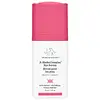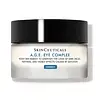What's inside
What's inside
 Key Ingredients
Key Ingredients

 Benefits
Benefits

 Concerns
Concerns

 Ingredients Side-by-side
Ingredients Side-by-side

Water
Skin ConditioningOctyldodecanol
EmollientGlycerin
HumectantBoron Nitride
AbsorbentCaffeine
Skin ConditioningSaccharomyces/Xylinum/Black Tea Ferment
Skin ConditioningCoconut Alkanes
EmollientCetyl Alcohol
EmollientCetearyl Olivate
Sorbitan Olivate
EmulsifyingNiacinamide
SmoothingMangifera Indica Seed Butter
Skin ConditioningHippophae Rhamnoides Oil
EmollientBis(Tripeptide-1) Copper Acetate
Skin ConditioningCaprylic/Capric Triglyceride
MaskingSclerocarya Birrea Seed Oil
HumectantDipeptide-2
Skin ConditioningPalmitoyl Tripeptide-1
Skin ConditioningPalmitoyl Tetrapeptide-7
Skin ConditioningCopper Lysinate/Prolinate
Skin ConditioningHesperidin Methyl Chalcone
AntioxidantGlycine Soja Oil
EmollientSodium Hyaluronate Crosspolymer
HumectantHydroxyethylcellulose
Emulsion StabilisingGlucose
HumectantBiotin
AntiseborrhoeicMethylglucoside Phosphate
Skin ConditioningRetinol
Skin ConditioningCeramide NP
Skin ConditioningTrideceth-6 Phosphate
EmulsifyingCoco-Caprylate/Caprate
EmollientLecithin
EmollientCetyl Palmitate
EmollientPanthenol
Skin ConditioningLeontopodium Alpinum Meristem Cell Culture
Skin ConditioningN-Hydroxysuccinimide
Skin ConditioningUbiquinone
AntioxidantCitric Acid
BufferingChondrus Crispus Extract
Skin ConditioningSteareth-20
CleansingThioctic Acid
AntioxidantTocopherol
AntioxidantChrysin
Skin ConditioningSclerotium Gum
Emulsion StabilisingSodium Citrate
BufferingPolysorbate 20
EmulsifyingXanthan Gum
EmulsifyingPotassium Sorbate
PreservativeLaureth-23
CleansingSodium Benzoate
MaskingChlorphenesin
AntimicrobialCaprylyl Glycol
EmollientSodium Hydroxide
BufferingSodium Carbonate
BufferingPhenoxyethanol
PreservativeSodium Chloride
MaskingChlorhexidine Digluconate
AntimicrobialPentylene Glycol
Skin ConditioningEthylhexylglycerin
Skin ConditioningWater, Octyldodecanol, Glycerin, Boron Nitride, Caffeine, Saccharomyces/Xylinum/Black Tea Ferment, Coconut Alkanes, Cetyl Alcohol, Cetearyl Olivate, Sorbitan Olivate, Niacinamide, Mangifera Indica Seed Butter, Hippophae Rhamnoides Oil, Bis(Tripeptide-1) Copper Acetate, Caprylic/Capric Triglyceride, Sclerocarya Birrea Seed Oil, Dipeptide-2, Palmitoyl Tripeptide-1, Palmitoyl Tetrapeptide-7, Copper Lysinate/Prolinate, Hesperidin Methyl Chalcone, Glycine Soja Oil, Sodium Hyaluronate Crosspolymer, Hydroxyethylcellulose, Glucose, Biotin, Methylglucoside Phosphate, Retinol, Ceramide NP, Trideceth-6 Phosphate, Coco-Caprylate/Caprate, Lecithin, Cetyl Palmitate, Panthenol, Leontopodium Alpinum Meristem Cell Culture, N-Hydroxysuccinimide, Ubiquinone, Citric Acid, Chondrus Crispus Extract, Steareth-20, Thioctic Acid, Tocopherol, Chrysin, Sclerotium Gum, Sodium Citrate, Polysorbate 20, Xanthan Gum, Potassium Sorbate, Laureth-23, Sodium Benzoate, Chlorphenesin, Caprylyl Glycol, Sodium Hydroxide, Sodium Carbonate, Phenoxyethanol, Sodium Chloride, Chlorhexidine Digluconate, Pentylene Glycol, Ethylhexylglycerin
Water
Skin ConditioningGlycerin
HumectantDimethicone
EmollientIsohexadecane
EmollientParaffin
PerfumingPropylene Glycol
HumectantSilica
AbrasivePolyglyceryl-4 Isostearate
EmulsifyingCetyl PEG/PPG-10/1 Dimethicone
EmulsifyingHexyl Laurate
EmollientNylon-12
Hydroxypropyl Tetrahydropyrantriol
Skin ConditioningMethylsilanol/Silicate Crosspolymer
Skin ConditioningPolyethylene
AbrasiveAscorbyl Glucoside
AntioxidantCaprylic/Capric Triglyceride
MaskingOctyldodecanol
EmollientPhenoxyethanol
PreservativeTocopheryl Acetate
AntioxidantAmmonium Polyacryloyldimethyl Taurate
Emulsion StabilisingPEG-6 Isostearate
EmulsifyingTriethanolamine
BufferingSodium Citrate
BufferingMethylparaben
PreservativeChlorphenesin
AntimicrobialCaffeine
Skin ConditioningTitanium Dioxide
Cosmetic ColorantEthylparaben
PreservativeMenthoxypropanediol
MaskingVaccinium Myrtillus Fruit Extract
Skin ConditioningHesperidin Methyl Chalcone
AntioxidantPentasodium Pentetate
Aluminum Hydroxide
EmollientStearic Acid
CleansingHesperetin Laurate
AntioxidantN-Hydroxysuccinimide
Skin ConditioningDipeptide-2
Skin ConditioningPalmitoyl Tetrapeptide-7
Skin ConditioningPalmitoyl Oligopeptide
CleansingChrysin
Skin ConditioningWater, Glycerin, Dimethicone, Isohexadecane, Paraffin, Propylene Glycol, Silica, Polyglyceryl-4 Isostearate, Cetyl PEG/PPG-10/1 Dimethicone, Hexyl Laurate, Nylon-12, Hydroxypropyl Tetrahydropyrantriol, Methylsilanol/Silicate Crosspolymer, Polyethylene, Ascorbyl Glucoside, Caprylic/Capric Triglyceride, Octyldodecanol, Phenoxyethanol, Tocopheryl Acetate, Ammonium Polyacryloyldimethyl Taurate, PEG-6 Isostearate, Triethanolamine, Sodium Citrate, Methylparaben, Chlorphenesin, Caffeine, Titanium Dioxide, Ethylparaben, Menthoxypropanediol, Vaccinium Myrtillus Fruit Extract, Hesperidin Methyl Chalcone, Pentasodium Pentetate, Aluminum Hydroxide, Stearic Acid, Hesperetin Laurate, N-Hydroxysuccinimide, Dipeptide-2, Palmitoyl Tetrapeptide-7, Palmitoyl Oligopeptide, Chrysin
 Reviews
Reviews

Ingredients Explained
These ingredients are found in both products.
Ingredients higher up in an ingredient list are typically present in a larger amount.
Caffeine is most associated with coffee, tea, and cacao. In skincare, it helps with calming inflammation and is rich in antioxidants.
While caffeine is used to treat cellulite and and dark circles, further studies are needed to prove this. It has been believed to help with these skin conditions due to its ability to dilate blood vessels and increase blood flow.
Some studies are looking into caffeine's ability to protect against UV rays.
Learn more about CaffeineThis ingredient is an emollient, solvent, and texture enhancer. It is considered a skin-softener by helping the skin prevent moisture loss.
It helps thicken a product's formula and makes it easier to spread by dissolving clumping compounds.
Caprylic Triglyceride is made by combining glycerin with coconut oil, forming a clear liquid.
While there is an assumption Caprylic Triglyceride can clog pores due to it being derived from coconut oil, there is no research supporting this.
Learn more about Caprylic/Capric TriglycerideChlorphenesin is a synthetic preservative. It helps protect a product against bacteria in order to extend shelf life. In most cases, Chlorphenesin is paired with other preservatives such as phenoxyethanol and caprylyl glycol.
Chlorphenesin is a biocide. This means it is able to help fight the microorganisms on our skin. It is also able to fight odor-releasing bacteria.
Chlorphenesin is soluble in both water and glycerin.
Studies show Chlorphenesin is easily absorbed by our skin. You should speak with a skincare professional if you have concerns about using Chlorphenesin.
Learn more about ChlorphenesinWe don't have a description for Chrysin yet.
Dipeptide-2 is a peptide. It can help to reduce the effects of aging.
Glycerin is already naturally found in your skin. It helps moisturize and protect your skin.
A study from 2016 found glycerin to be more effective as a humectant than AHAs and hyaluronic acid.
As a humectant, it helps the skin stay hydrated by pulling moisture to your skin. The low molecular weight of glycerin allows it to pull moisture into the deeper layers of your skin.
Hydrated skin improves your skin barrier; Your skin barrier helps protect against irritants and bacteria.
Glycerin has also been found to have antimicrobial and antiviral properties. Due to these properties, glycerin is often used in wound and burn treatments.
In cosmetics, glycerin is usually derived from plants such as soybean or palm. However, it can also be sourced from animals, such as tallow or animal fat.
This ingredient is organic, colorless, odorless, and non-toxic.
Glycerin is the name for this ingredient in American English. British English uses Glycerol/Glycerine.
Learn more about GlycerinHesperidin Methyl Chalcone is an antioxidant and is a type of silicone.
We don't have a description for N-Hydroxysuccinimide yet.
Octyldodecanol is a fatty alcohol. It is primarily used to enhance the texture of products.
As an emulsifier, Octyldodecanol helps prevent the oils and waters from separating. It also prevents ingredients from creating foam when shaken.
Octyldodecanol is created by reducing fatty acid to an alcohol.
Due to its high molecular weight, it does not get absorbed into the skin.
Learn more about OctyldodecanolPalmitoyl Tetrapeptide-7 (formerly Palmitoyl Tetrapeptide-3) is a lab-made peptide with anti-inflammatory and skin-repairing benefits. It's made up of four amino acids (glycine, glutamine, proline, and arginine) and palmitic acid (which helps it penetrate skin more effectively).
This ingredient helps reduce inflammation by limiting the production of interleukin-6 (IL-6), a chemical that triggers inflammatory responses, particularly after UV exposure.
Less inflammation = slower collagen breakdown and a longer-lasting, youthful appearance.
Palmitoyl Tetrapeptide-7 also stimulates collagen production and supports a healthier skin barrier.
Over time, this can improve skin firmness, hydration, and reduce the appearance of fine lines. It’s commonly paired with Palmitoyl Tripeptide-1 in the well-known Matrixyl 3000 complex for enhanced anti-aging effects.
This ingredient has been shown to be effective and safe in cosmetic use and you'll typically find it in small amounts (less than 0.01%).
Due to its palmitic acid base, it may not be safe for Malassezia folliculitis.
Read more about other common types of peptides here:
Learn more about Palmitoyl Tetrapeptide-7Phenoxyethanol is a preservative that has germicide, antimicrobial, and aromatic properties. Studies show that phenoxyethanol can prevent microbial growth. By itself, it has a scent that is similar to that of a rose.
It's often used in formulations along with Caprylyl Glycol to preserve the shelf life of products.
Sodium Citrate is the sodium salts of citric acid. In skincare, it is used to alter pH levels and acts as a preservative.
Its main functions are to maintain the pH of a product and neutralize metal ions.
The acidity of our skin is maintained by our glands and skin biome; normal pH level of skin is slightly acidic (~4.75-5.5).
Being slightly acidic allows our skin to create an "acid mantle". This acid mantle is a thin barrier that protects our skin from bacteria and contaminants.
Learn more about Sodium CitrateWater. It's the most common cosmetic ingredient of all. You'll usually see it at the top of ingredient lists, meaning that it makes up the largest part of the product.
So why is it so popular? Water most often acts as a solvent - this means that it helps dissolve other ingredients into the formulation.
You'll also recognize water as that liquid we all need to stay alive. If you see this, drink a glass of water. Stay hydrated!
Learn more about Water